DIGITAL DISCIPLES, ZOMBIE CARS, AND ENOUGH DELUSION AND HUBRIS TO POWER THE NEW EMERALD AUTO CITY JUST OVER THE HILL. WHAT COULD POSSIBLY GO WRONG, BESIDES EVERYTHING? THAT’S RIGHT, IT’S TIME FOR THE AUTOEXTREMIST YEAR IN REVIEW!
 Saturday, December 15, 2018 at 09:36AM
Saturday, December 15, 2018 at 09:36AM By Peter M. DeLorenzo
Detroit. Ah yes, 2018, what a spectacular time to be in the automobile business. With the promise of new beginnings and untold profits dancing in "The New Visionaries'" heads, a Next Frontier marked by a horde of shiny happy zombie cars careening across the landscape, and a blissfully unaware populace with joker-like grins plastered on their faces as they revel in the mindless, pay-as-you-go un-involvement – what could possibly go wrong?
Meanwhile the real-world market has been upended by actual paying customers and their insatiable desire for Crossovers, SUVs and Trucks, to the point that legacy auto companies like GM have been caught out of position and unprepared, forcing it to close underperforming plants and cut thousands of workers. GM blames the market conditions, but I place the blame squarely on management for their lack of planning and inability to anticipate where the market was going.
Add to this chaotic situation the headlong rush of European automakers into Battery Electric Vehicles, while completely ignoring the fact that consumers aren’t necessarily ready to buy them, and remarkably enough you have – What could possibly go wrong? Part II.
I suppose we should revel in the fact that we currently have the finest cars and trucks ever built at our disposal, and that the internal combustion engine will be around for a long, long time to come, yet I can’t help but think that this is all going nowhere good, and that unbridled chaos will be the norm from here on out. Not that it hasn’t been chaotic all along, but we’re entering unchartered territory at this juncture, and the dial is being twisted well past “eleven.”
On these happy notes, let’s review what happened in 2018, shall we? Starting way back in January at the Detroit Auto Show…
Memo to car companies Lost in the Cloud of What Could Be: You better pay attention to your core automotive business for the foreseeable future, because if you don’t, you won’t have to worry about What’s Next, because you’ll be What’s Gone. Speaking of misguided meanderings, the industry’s unwavering fascination with “What’s Next” is consuming all that is righteous and holy with this business. Normally levelheaded executives (at least as much as they can be) are so hell-bent on carving out a piece of the autonomous future for their companies that they’ve completely lost the plot. It’s fine to pontificate about the transportation landscape of the future, but the reality is much less sanguine. In fact, it’s flat-out grim. With manufacturers developing well over a hundred BEVs (Battery Electric Vehicles) for the market between now and 2022, the multi-billion-dollar question remains: Is the infrastructure going to be ready for anything close to what’s needed even under the very best scenario? How about, no? It isn’t even going to be close, in fact. So, the immediate future is gasoline-electric hybrids. That’s ICEs (Internal Combustion Engines) with electric motor support. It’s rational, it’s achievable, and it’s already here and deeply in play. (“UNBRIDLED OPTIMISM FOR NO APPARENT REASON, ASSORTED PHANTOM THREADS AND ENOUGH OFF-SITE REVEALS TO KILL THE WHOLE DAMN THING ALTOGETHER. YOU CALL THIS AN AUTO SHOW? TRUCK, YEAH!” 1/17/2018)
A new level of stupid, brought to you by BMW. BMW opened its press conference with a video of an eight-hour drift that apparently set a new “Guinness World Record.” Yes, you read that correctly, as in, WTF? If there were any doubts out there that BMW has completely lost it, they were buried in one fell swoop. This was followed by a word from its CFO. Now, it doesn’t get any better than when a car company brings its finance guy up to bore everyone to death; I mean, really. You’d be better off if you had your PR minions hand out forks so people could stick themselves in the eye at that point. And this guy didn’t disappoint. But when I heard the words “our clear strategic focus…” drone-drone-drone and “we deliver on our promises…” drone-drone-drone, it was most definitely time to leave. (1/17)
Yes, they look cobbled together and unfinished, what’s your point? Hyundai introduced its Veloster N and it became apparent to me that between this car and the Honda Civic Type R the Angry Ant School of Design has completely taken over the hot hatch market (the Veloster was to make its debut in Marvel Studios “Ant-Man and The Wasp” so maybe that had something to do with it). Don’t tell me about the performance of these cars because they’re so painful to look at that it’s borderline depressing. This isn’t a function-over-form thing, either. These machines look cobbled together and unfinished. And that’s being kind. There has to be a better way. (1/17)
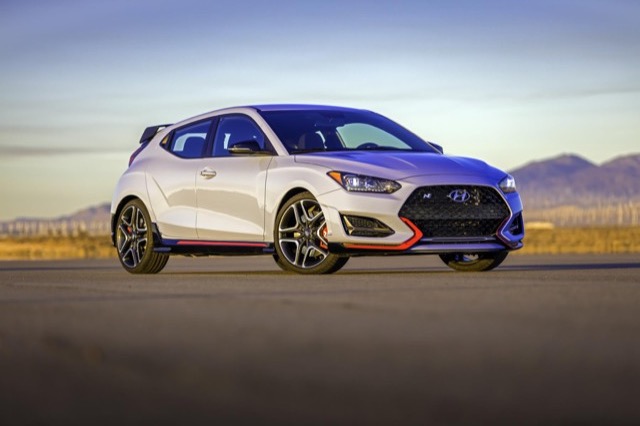
(newspressUSA)
The 2019 Hyundai Veloster N.
We’re in search of a look. Anyone? Bueller? Nissan has been flopping and floundering about when it comes to design for so long that we gave up hope that they’d ever emerge from The Darkness a long time ago. This is the latest attempt by Nissan to come up with a new SUV design language, the Xmotion Concept. Here it is in a few words: Chunky. Aggressive. Busy. Ungainly. Needs More Work. And Trying Too Hard. (At least the interior was weirdly cool.) Combine this with the fact that the assembled Nissan production models on the show floor were so tedious and uninspired that they were instantly forgettable, and nothing has really changed when it comes to Nissan. I hesitate to say that they need to go back to the drawing board/computer screen and start over, because they always seem to peg the Wince Meter when they do. Ah well, not everyone can have it goin’ on in this business. (1/17)
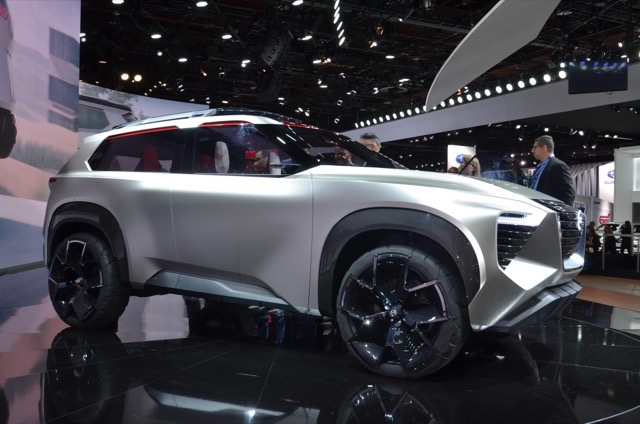
(newspressUSA)
The Nissan Xmotion Concept.
That’s all well and good, but we’re going to need a lot of NZT to get past that front end. Lexus PR minions waxed eloquently about the new Lexus LF-1 Limitless SUV concept, saying, “Like molten metal being forged into a fine Japanese sword, the lines of the Lexus LF-1 Limitless concept have the potential to shape the future of a flagship luxury crossover for Lexus.” It does have a beautifully rendered profile and side sculpting, and the back end is very nice, especially with its avant-garde taillight design, but then it goes completely off the rails when you get around to the front end. Maybe they needed more molten hot magma from Dr. Evil, or, sticking to the movie theme, a whole bunch of NZT from Limitless. At any rate, an excellent effort from Lexus designers that almost hit it out of the park. (1/17)
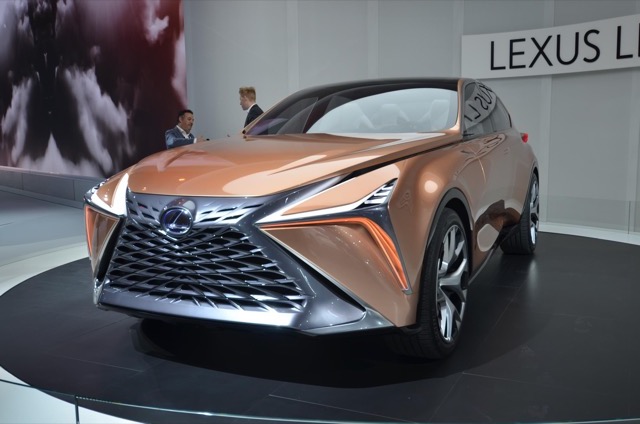
(newspressUSA)
The Lexus LF-1 Limitless.
“What’s the Point of Having Fuck You Money if You Never Say Fuck You?” Tough, improbably desirable, undeniably cool and a little nonsensical, the redesigned Mercedes-Benz G-Class was the one production-ready vehicle at the show that people couldn’t get enough of, or say enough about. I spent 30 minutes around this vehicle at one point and the appeal was universal, with the typical comment being, “I’ve always wanted one of these.” Extremely well executed – especially the interior - but pricey and out of reach for 99 percent of the consumer-buying public, the G-Class is a flat-out hit nonetheless. (1/17)
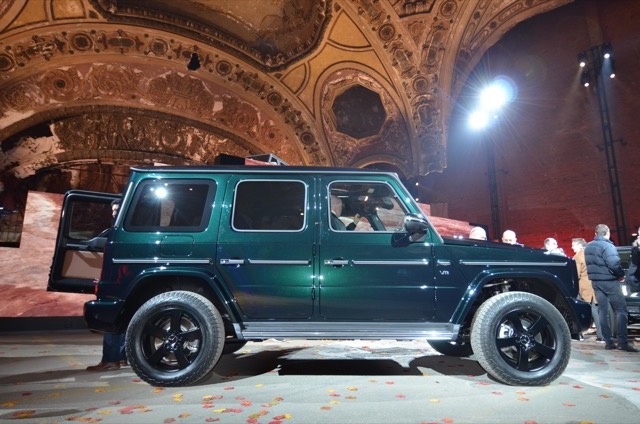
(newspressUSA)
The Mercedes-Benz G-Class.
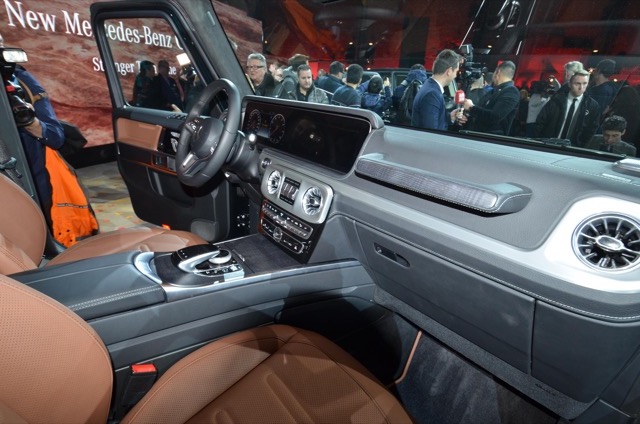
(newspressUSA)
The Detroit Auto Show as we know it is dead, long live the new Detroit Auto Show. The 2018 version of the Detroit Auto Show was a lackluster exercise almost completely devoid of excitement. A lot of people attributed that to the fact that there were not enough concept cars from the manufacturers and that made for a dull show. There is some truth to that. People go to movies for the escapism and entertainment. Similarly, when people go to auto shows – even those people connected to the various car companies and suppliers here who are beyond jaded – they like to kick the tires of the vehicles they could buy or dream to buy of course, but they also like to see creativity and blue-sky stuff. That was decidedly lacking in Detroit and it hurt the show tremendously.
I realize this will be a highly unpopular column around these parts (gee, there’s something new –WG), because if we go by what those in the local media have reported the 2018 Detroit Auto Show was another grand slam home run and runaway success. But this kind of “homerism” by the media is just kicking the can down the road. (THE DETROIT AUTO SHOW IS DEAD. NOW WHAT? - 1/24)
With the Detroit Auto Show in our rearview mirror, these were the Five High-Octane Truths about the car business right now:
1. Data is not the new oil. The car companies in a headlong rush to accumulate data on consumers are kidding themselves and it’s a fool’s errand. This goes back to the idea that some well-meaning executives actually believe down to their monogrammed shirts that the connected automobile will supplant the cell phone as the personal communication device of the future. They envision an idealistic, Shiny Happy Future where our automobiles remember our favorite restaurants, our favorite place for a cup of coffee, our favorite dry cleaners, the best place for organic snacks and so on, and that somehow this knowledge will drive owner loyalty and revenue back to the automakers that will translate into untold billions in profit. But the idea that we will all just lap this up like there’s no tomorrow is ridiculous. The automobile will never replace the cell phone on the human connectivity scale, because that ship has sailed. The auto manufacturers creating huge data farms in order to glean countless bits of information about consumers that in their minds will change the world are in for a rude awakening. This is unmitigated bullshit on a grand scale, folks, and the car companies who are immersing themselves in this pursuit are in for a rude awakening.
2. The UAW is toast. The ugliness of the pay-to-play scandal that has grabbed this business by the scruff of the neck is not going away anytime soon. In fact, it is growing, with more indictments expected. The news that FCA officials paid more than $1.5 million to UAW officials and employees to sway union contract negotiations is part of a wider $4.5 million corruption scandal involving the foreign-owned automaker. The Feds said last week that the FCA executives’ actions were intended to corrupt UAW contract negotiations to favor Fiat Chrysler and that the corruption was more widespread than previously disclosed. In fact, it was going on for years. Perhaps this type of payola may be standard operating procedure in Corporate Italia, but it doesn’t fly here, and with the UAW on very thin ice as it is, the outcry from the rank and file is growing louder by the day.
3. Are these guys really that stupid? Why yes, yes they are. The news, reported by the Stuttgarter Zeitung newspaper and Bloomberg, that the Volkswagen Group, Daimler and BMW sponsored tests that exposed 25 people as well as monkeys to diesel exhaust fumes – which can cause respiratory illness and cancer – at a clinic used by the University of Aachen, rocked the auto world. The report, citing annual reports from the European Research Group on Environment and Health in the Transport Sector, or EUGT, which closed last year, followed a report from the The New York Times that confirmed the tests using monkeys. Daimler immediately condemned the experiments “in the strongest terms” but, really? As in WTF? Were these companies that driven to save the Diesel that they would acquiesce to such nonsense, or were they just following orders?
4. The Answer to the Question that Only a Few People Are Asking. The mid-size truck segment is as flat as a pancake, yet Ford and Jeep are jumping in (albeit in over a year) to go up against the Toyota Tacoma, Chevrolet Colorado, GMC Canyon, Honda Ridgeline and the Nissan Frontier. What gives, exactly? Is the demand there? Not really, but the automakers playing in that segment are afraid of being left behind. Of what, I’m not really sure. If a car company really wanted to make a splash in this segment it would come in with a product entry that was bare bones and priced aggressively, costing thousands less. That’s not happening and it’s the wrong move.
5. Buick’s station wagon to nowhere. Buick operatives are positively giddy about its new Regal TourX, its “don’t-call-it-a-station-wagon-call-it-a-crossover” entry into the market, insisting that they will attract buyers from Audi, Subaru and Volvo, except that I can assure you that buyers/drivers of those cars are about as likely to visit a Buick showroom as the Lions are of winning the Super Bowl next year, no matter what Buick marketing operatives have talked themselves into believing. On the one hand I can actually appreciate the kind of unbridled optimism displayed in small doses here, but on the other hand I recoil at the sheer, flat-out lunacy and delusional thinking. In fact, it’s frightening when you spend too much time thinking about it.
Aw well… getting back to this aforementioned “selling air” business. It’s not that auto executives aren’t proficient in “selling air,” some are quite adept at it as a matter of fact, but still, suggesting that the automobile manufacturers can pivot with a dramatic certainty and become technology companies overnight is simply not going to happen and is a totally unrealistic notion.
And frankly, they don’t have to either. Instead of trying to become something they’re not and will never be, the auto companies need to maximize their expertise in manufacturing and mass production and be an essential part of the solution for our transportation future without being marginalized into irrelevance by it.
But this is anathema to the current "Detroit” mindset. How dare I have the temerity to suggest that the collective “Detroit” doesn’t have the talent or the wherewithal to compete in this arena, right? Let’s back that up a bit because this is not what I’m saying. There’s no question that the talent in this region is prodigious (as the denizens of Silicon Valley have become well aware of). What I am saying is that yes, of course, “Detroit” could become experts in this arena well down the road, but at what ultimate cost? Does that mean “Detroit” should subjugate its knowledge accrued over a century to all of a sudden become what they really don’t have to be, or should be?
The short answer? No. We are going to be living with cars and trucks powered by ICEs (Internal Combustion Engines); Hybrid electric vehicles with ICEs; and Battery Electric Vehicles (BEVs) for decades to come. Let me say that again, for decades to come. Yes, autonomous and ultra-connected vehicles will play a role in the overall transportation equation going forward, but it will not be the dominant role. Instead, their impact will be confined to urban centers, delivery vehicles, and other select situations where favorably applicable.
Does this suggest that the car companies throwing around money like drunks at a bottler’s convention in the hopes of catching up to Silicon Valley is a smart strategy? Are car companies that ignore their areas of expertise in the hopes of being part of a transformative transportation initiative guaranteed untold riches and success? Clearly, they are not.
The automobile companies who keep things in perspective going forward will be the ones that survive, plain and simple. The auto companies that get caught up in the frenzy will be crippled if not eliminated altogether. (“SELLING AIR TAKES ON A NEW URGENCY IN THE MOTOR CITY, PLUS FIVE EXASPERATING HIGH-OCTANE TRUTHS.” – 1/31)
Shockingly cynical and blatantly offensive; other than that, it was a monumentally shitty commercial. Starting with a spot for Ram trucks called “Built to Serve," which used words from Martin Luther King Jr., Olivier Francois went to the well one more time in search of this year’s “Farmer.” Except it backfired, horribly. Why? FCA’s agency cherry-picked Dr. King’s own words from a sermon that he delivered 50 years ago at Ebenezer Baptist Church in Atlanta, which was, remarkably enough, a diatribe against rampant consumerism, particularly mentioning overspending on cars. He even went so far as to chastise those who “are so often taken by advertisers.” Uh, WTF? Francois offered up a lame excuse that he had the complete approval from the Martin Luther King Jr. estate, but that is no excuse. The outcry and outrage on social media was deservedly swift and unrelenting. This was a complete disaster of a spot, one that upon closer inspection was shockingly cynical and blatantly offensive. (“FCA’S EMBARRASSING DISPLAY ON THE SUPER BOWL.” – 2/7)
They don’t call Nissan “perpetually adrift” for nothin’. Nissan, the Japanese brand that roared into the U.S. market as Datsun and achieved notable success with some feisty products and one of the all-time great advertising themes – “We Are Driven” – (they never should have changed the name to Nissan, by the way, but that’s another column) lost its way in a big way when Carlos Ghosn put his spurs into the brand.
One of the most overrated executives in the auto business, Ghosn pushed U.S. Nissan dealers into a churn-and-burn frenzy in order to achieve absurd sales targets and market share, and consequently the Nissan brand was degraded to the point that Nissan dealers became the Beacon of Hope for subsidized payment shoppers, aka “How much is that Altima a month?”
Just this week, in an interview that appeared in Automotive News, Nissan Motor Co. CEO Hiroto Saikawa lamented the fact that Nissan’s “M.O.” of massive incentives and fleet sales in order to meet Ghosn’s overly optimistic sales and market share targets had taken its toll on the Nissan brand, resulting in diminished brand value and reduced profitability.
Gee, who would have thunk it? That’s only the biggest “Duh” of this or any other year. Nissan has been going down this road for years, thanks to Ghosn, and now the new guy tasked with revitalizing the brand has his work cut out for him. (“BRAND SPANKING.” -2/14)
I am reminded of those ominous words of narration by Joe Pesci’s character – Nicky Santoro – in “Casino.” I’m paraphrasing him here, but I can imagine Hyundai operatives sitting around a conference room table right now saying, reluctantly: “We fucked it all up.” When I perused the Genesis website the company takes great pains to put their “Vision and Mission” for the brand in prominent position. It states the following:
We strive to create the finest automobiles and related products/services for connoisseurs around the globe. Our team of talented individuals around the world is led by our company’s values, where respect for one another in the quest of finding the best solutions for refined individuality dominates our work ethos.
Yes, of course, you could plaster those words on any luxury automaker’s website, but in this specific case they ring hollow. Connoisseurs around the globe? Please. And spare us the regurgitation of company values, because clearly the Hyundai work ethos counts for absolutely nothing at this point.
Hubris, arrogance and serial incompetence have defined the Hyundai modus operandi for so long that I’ve lost track. They operate in this vacuous netherworld of two steps forward and five back, and yet they insist on singing the “we got it goin’ on” song to themselves in an aria that is relentlessly off-key and stale. That Hyundai operatives have blown the launch and now re-launch of the Genesis brand was surprising only in its scope and its rapid descent into mediocrity. (”BEATING A DEAD (FLYING) HORSE.” -2/22)
Chevrolet marketers: Delusion + Hubris + Serial Incompetence produces the worst advertising in the business. Nicely done. Running glorified “Tier 2” Dealer Advertising in national advertising buys is an ugly development that has to stop. The primary shit disturber behind this revolting development is none other than the marketers at GM’s Chevrolet division plying their trade down in the Silver Silos hard by the Detroit River. These serially incompetent marketing operatives (of widely varying degrees of ability, I might add, usually rising just below the line of half-assed) have deluded themselves into believing that they seriously have it goin’ on, that they somehow have absconded with the golden key to the secret formula of marketing success. They’re actually so convinced in their belief that they’ve figured it all out that they bring a large measure of hubris to the proceedings, which would be remarkable and shocking if it weren’t for the fact that it’s GM, and that everyone in the marketing/advertising field has come to expect “delusional hubris” as part and parcel of GM marketing’s “M.O.” But just because it is GM and everyone has grown to expect the worst - and subsequently is rarely disappointed - that doesn’t make it right.
Over my career, I have never heard the kind of negativity associated with a particular automotive advertising campaign the likes of which I hear when a Chevrolet spot comes up in conversation, both with marketing pros and civilians alike. I would say “universally panned” would be an apt summary of the comments I hear, and that’s being charitable. People simply tune them out and turn them off. I would venture to guess that this advertising has done more to instill an air of mediocrity associated with the brand than any other campaign in Chevrolet marketing history, and this in spite of the fact that Chevrolet is actually offering some excellent products at the moment.
Running insipid dealer spots isn’t a substitute for real live national advertising (image or product) that actually communicates something that’s memorable and worth repeating (see Subaru). Never has been, never will be. And two factors are directly responsible for this phenomenon at GM 1. Not enough seasoned advertising/marketing pros and, 2. A lack of fundamental “buck stops here” marketing leadership in the upper echelon of management.
The reason GM happens to strike out in both instances is that they are grossly underrepresented when it comes to having serious marketing pros at their disposal, and there is a steadfast refusal at the very top of the company to hire a proper marketing chief. I’ve brought up this last point repeatedly over the last five years, but both Mary Barra and Dan “I Am” Ammann have made it perfectly clear that they have little or no respect for the marketing function, to the degree that they’ve talked themselves into believing that the individual divisions can handle it and that C-Suite oversight is not needed or desired. Well, it shows. The Chevrolet “national” retail advertising is relentlessly dreadful, with no redeeming value whatsoever. It has cheapened the brand and made people skip over Chevrolet as being a nonstarter, also-ran brand because other than the big pickups and SUVs, there is no “there” there. (I am leaving the Corvette out of this discussion because it is an outlier to the rest of the Chevrolet brand.) (“NOW THAT DETROIT AUTO SHOW ORGANIZERS HAVE FINALLY SEEN THE LIGHT, THERE ARE A COUPLE OF OTHER THINGS THAT NEED TO CHANGE AROUND HERE.” -3/7)
Here’s to the ones who dream. Though I'm tired of using the term "swirling maelstrom" to describe this business, I have yet to find a more apt descriptor. It's a land where you're only as good as your last hit, a state of mind where you're forced to make what's happening right now work, while struggling to make what's happening next come into focus. It's a cruel, nonsensical world that punishes those who would deign to march to a different drummer, but it's only those who dare to break through that gauntlet who rise to the top.
It's easy to get mired in the minutiae of this business; the endless meetings, the constant "reviews," the endless hand-wringing and second (and third) guessing. Overthinking might be an operational component in corporate America, but in the automobile business it's a full-blown cottage industry, which makes effectual decisions extremely hard to come by. Why? Because 90 percent of the time is spent worrying about what an upper executive in question might want or might be thinking, which forces underlings to become interpreters and acquire the skill set of nuanced anticipation.
This business is unfortunately littered with so-called genius executives who parachute into the decision process, make a few pronouncements, then helicopter out. And the worst part of this phenomenon is that they come back six weeks later and question why a particular direction was undertaken, totally forgetting that's what he or she directed. Thus, time, effort and money are wasted at a prodigious rate because executives are too self-absorbed to get their heads out of their asses and realize how destructive their behavior is. And no, it isn't exclusive to the automobile business, but it's decidedly more pathetic when product programs or advertising campaigns are on the line.
And yes, product. Product is the straw that stirs the drink, the raison d'etre of the automobile business. It's not selling air. It's not about what a company's vision of down the road will be. That's all well and good and fine and wonderful, but it's not the business now and it isn't the business for the next 36 months. It's about product cadence, which means having the right products, at the right time, for the right market segments. Whatever a company's vision is for the future doesn't matter if it isn't generating serious profits to fund that future.
Remarkably enough, some companies forget all of this. They get sidetracked and off kilter, they chase their tails, they start listening to the dulcet tones of their own thought balloons, and they become buried under the heavy mantel of their own hubris. In short, they lose their way and start making mistakes. Except this isn't a business that tolerates mistakes. It's not a strike three business, either. Two strikes and you're out. And in this league, playing catch-up is not only a brutally tough and long road, sometimes it just doesn't work out. And in the new reality of this globally-driven automobile business, some car companies are just not going to make it.
The companies stocked with True Believers, the ones unafraid to dream, the ones focused on delivering the best in all aspects of this business - Design, Engineering, Product Development, Marketing - will succeed. It not only requires savvy management, it requires a complete cessation of the normal bureaucratic cesspool that paralyzes these companies, which means loosening the reins of the True Believers so that they can do what they're capable of doing.
When it comes to The Future of this business, I will bet on the companies who value their True Believers, because those companies who refuse to do so will be ringing their death knells. (“HERE'S TO THE ONES WHO DREAM.” -3/14)
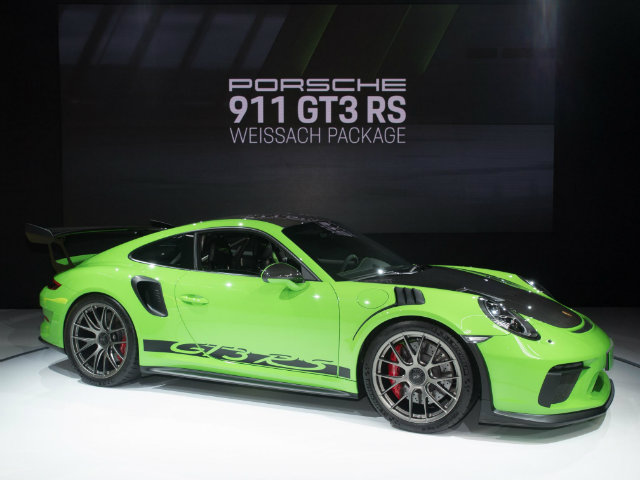
(newspressUSA)Porsche 911 GT3 RS.
I knew this was coming and it was probably inevitable, but we have reached Peak Porsche. This isn’t about the fact that it’s predominantly a truck brand, because every automaker worth its salt is a truck brand now. There was something missing about Porsche at the New York show, a hollowness that was palpable. The German manufacturer had on display a yellow 911 T, a lime green 911 GT3 RS, a silver Cayenne and two white Panamera Hybrids (one of them a Sport Turismo). The most alluring Porsche on display? A beautifully restored white 356 Cabriolet from Porsche Classic. What does that tell you? My feeling is that endless variations of the 911 is a product strategy that has been played out. And the modern Porsche models on display felt calculated and oddly uninvolving. The GT3 RS seemed like it had been done 1000 times before, because well, it has; and the 911 T is yet another blatant money grab adhering to the traditional Porsche marketing formula, which goes something like this: De-contenting + Limited Production = Piles of Ca$h. And the Panamera models were coldly antiseptic and off-putting, like they showed up to a party that they weren’t invited to.
Memo to the brainiacs at Porsche: you have reached a critical juncture in your history, and I'm not even sure the much-touted, all-electric "Mission E" machine will be enough to save you. Porsche has become ubiquitous in the leafy suburbs and urban centers all across the country, but is that a good thing for the long-term health of the brand? I will answer that for you: no, it isn’t. We watched as BMW strategists embarked on a strategy of putting a BMW in every neighborhood in America, chasing niches both real and imagined, and the result is that the brand has lost its luster. And now Porsche seems to be doing the same.
Porsche operatives need to ask themselves the following: What is Porsche? Why does Porsche exist? Where do we – as a company – go from here? And why should we – as enthusiasts – care? And remember one very important thing, just having hybrids and BEVs does not mean the brand will survive. (4/4)
I had my own lingering questions about Alfa Romeo. Is it viable in this market? Does it have a real chance? How does it feel? How does it drive? How is it to live with on a daily basis? There really is only one way to get answers to those questions from my perspective. And it’s not by having an Alfa to drive for a week. So, I acquired a 2018 Alfa Romeo Stelvio Ti AWD. And no, it isn’t being provided by the manufacturer for a free, long-term test drive. I engaged in this process like any buyer would – I went to the dealer, I got the lease numbers and I should be driving it today.
Did I need to do this? No, but as critical as I’ve been of FCA through the years, I am going to give the Stelvio a real shot. And I will provide occasional updates in our “On the Table” column. Incredibly enough, it will be only the third Italian car I’ve ever owned. The first was a used ’68 Fiat 850 Coupe, and then there was a new ’80 Fiat Strada, because I worked on the sales training materials for that car. And now, the Stelvio. I don’t know if it’s a leap of faith, but it’s a leap nonetheless. And a giant “We’ll See.” (“A GIANT ‘WE’LL SEE.’“ - 4/11)
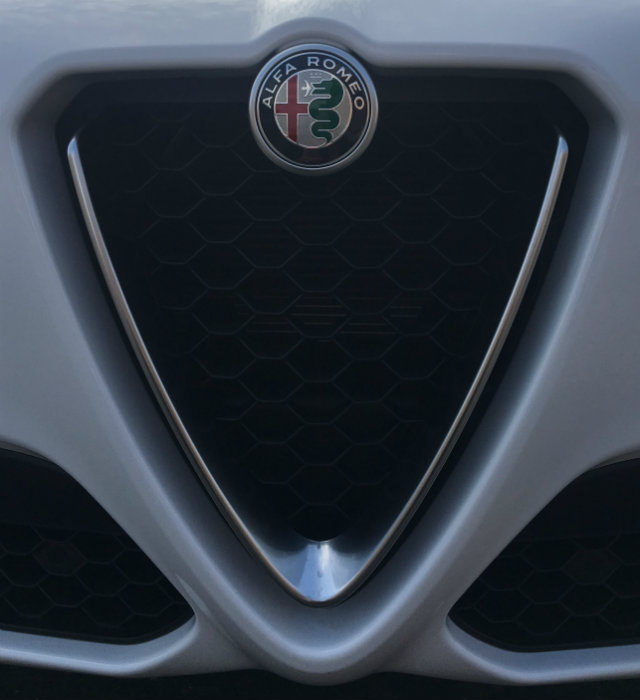
In the end, Johan de Nysschen was given a list of issues that needed to be addressed, many of them clearly not consistent with his vision for the brand, so he agreed to disagree and walked, saying, “It happens. It’s not personal. It’s business.” He’s right, of course, and make no mistake de Nysschen will surface again, as there are any number of car companies that could use his experience and visionary perspectives.
But now, GM has tapped its former head of operations in Canada, Steve Carlisle, to run Cadillac. A longtime GM veteran, Carlisle will be giving a new set of marching orders, many of which will most likely move away from de Nysschen’s previous directional attachments.
But as you might expect, I have my own set of recommendations for saving Cadillac:
1. Move Cadillac in a new strategic direction. As I said previously, ignoring Cadillac’s historical legacy is a nonstarter and an egregious mistake. Despite decades of German auto making superiority, the Cadillac name still resonates around the world as one representing the best of the best. It may not live up to the classic moniker “Standard of the World,” but it’s still the legacy that must be pursued. Cadillac should stand for luxury, elegance, power and design leadership. In short, Cadillac should be allowed to be Cadillac. It doesn’t have to live up to some other car company’s ideals, because living up to its own historical legacy should be impetus enough to aspire to greatness. The True Believers in Design, Engineering and Product Development understand all of this implicitly. And it’s time to refocus their energies on creating the Best of Cadillac.
2. Bring the names back. Starting with the established Escalade, rename the XTS the Fleetwood and go from there. Cadillac has a deep reserve of names (Eldorado, anyone?) along with more recent names like Ciel, Elmiraj and Escala. Names resonate. Names imbue character and personality. Cadillac has some of the best names available in this business. Use them. Now.
3. Gut the portfolio and start over. I’ve seen the new Escalade and it will continue to be a monster hit, if not more so, but from there big changes need to be made. Start by deleting the ATS and the CTS immediately. Then take the Fleetwood (formerly known as CT6) and give it an avant-garde, future-defining Cadillac skin. Cadillac won’t need another sedan if it’s done right. Do the same with the XT5; it’s nice, but nice isn’t anywhere near good enough. The XT5 needs to be better by half. The XT4? Start over. There’s no “there” there. Cadillac had time to make the XT4 a segment-leading product and it isn’t even remotely close, which is disheartening.
4. Say goodbye to the V series. Look, as AE readers know, I like performance machines as much as anyone, and the CTS-V and ATS-V are some of the best driver’s cars in this business. They are examples of the kind of work GM’s best and brightest can do when they set their minds to it, and they are indeed impressive machines. But that doesn’t mean they need to be Cadillacs. In fact, their architectures would be fine starting points for the new Corvette Division that I have been talking about for more than five years now at least. This would take real vision, however, and it would be a real departure in order for GM management hierarchy to seriously consider it. But if Porsche can do it, I firmly believe GM’s True Believers could do it just as well if not better for a new Corvette Division.
5. Delete the Cadillac Racing program. As most of you out there know, I am a huge proponent of racing as a genuine marketing tool when it is applied properly. Racing benefits Engineering Research and Development, and it’s the most worthwhile training ground for young engineers that there is. But that doesn’t mean every racing program has merit and context. Let’s face it, GM Racing’s decision to compete in IMSA’s top prototype series with “Cadillac-branded” prototypes was a politically expedient one that really had nothing to do with Cadillac as a brand. And it really will have nothing to do with the Cadillac brand going forward. When the new mid-engine Corvette arrives in IMSA's GTLM class, that would be the time to re-brand the GM Racing prototypes as well.
6. And Cadillac marketing needs to be overhauled too. A new divisional strategy will require a new marketing strategy, because flipping a switch to "tune up" the advertising never works, especially in this situation. And it's up to Deborah Wahl, Cadillac's new CMO, to figure it all out. She has the relevant experience, but does she really know what she's getting into? Does she understand that Barra and Ammann fundamentally do not believe in the power of marketing and advertising? At least not enough to hire an actual CMO for the executive suite, who would then lead all of the divisional marketing efforts? Why do you think they leave it to the divisions? Because they don't want another seven-figure salary parked in the executive suite, and they pay dearly for that misguided notion every single day. Does Cadillac marketing and advertising need to be overhauled? Yes, of course it does. But without a carefully thought-out strategy that would point Cadillac in the right direction, none of my previous points will matter one bit.
Ms. Barra and Messrs. Ammann and Carlisle need to ask themselves the following hard questions: What is Cadillac? Better yet, what should Cadillac be about going forward? Then instead of paying lip service to the brand they need to become True Believers, because the Cadillac name has resonance and power and a genuine historical legacy that could and should become the foundation for greatness again. (“WHERE DOES CADILLAC GO FROM HERE?” - 4/25)
Hard lessons for the denizens of Dearborn. And what the Ford executives were saying made sense of course, as consumers’ need for versatility, usability and adaptability in their vehicles shows no signs of abating, and Ford would be stupid not to reconfigure its product portfolio to take advantage of a trend that is not going away any time soon, as I said previously. Unfortunately, the dominant takeaway in the media and the angle that was splashed over a wide swath of media outlets across the country was that Ford – in spite of all of the explaining and justification for its future product moves – had somehow blown it and even let the American public down, which is a giant bowl of Not Good from Ford’s perspective.
This should be a hard lesson for the denizens of Dearborn, however. Catering to Wall Street is a dangerous game, especially when the domestic automobile industry has always been considered an anachronistic afterthought from a forgotten time languishing in the flyover states. The auto business is too down and dirty for the swells and smugly defined hordes that fancy the bright and shiny objects over everything else, which is exactly why Elon Musk has gotten away with squandering billions while Wall Street keeps propping up Tesla stock against all rational evaluations.
And don’t think ego isn’t playing a role in this either. It grinds the executive team at Ford to no end that GM’s stock has performed appreciably better, and that the GM executive team is considered to have it going on by the Wall Street types, while Ford doesn’t. Jim Hackett in particular has been taking direct broadsides from Wall Street, as they fail to see why they should be buying into Hackett’s somewhat esoteric vision for Ford at this juncture. Hackett has been going on the counterattack to deflect this criticism, embarking on a ruthless cost-cutting initiative that is reaching into every corner of the Ford organization in an effort to demonstrate to Wall Street that it will be lean and fit for the future. (I have one major caution for Mr. Hackett, however, and that is that you can’t cut your way to prosperity in this business; this has been proven time and time again.)
The harsh reality, unfortunately, is that to a large degree Wall Street’s perspective of Ford is not fixable. It is an ingrained notion that, fair or unfair, has been lingering over the company for decades. And there are no switches available to be flipped to fix this either. The bottom line is that the Ford management team’s obsession with justifying the company’s existence for the edification of Wall Street is not likely to yield the results they’re hoping for.
In the meantime, since its future product announcement didn’t exactly set the world afire, the Ford executive team needs to press the reset button and focus on the task at hand. That means focusing on designing, engineering and building the best products they can muster for every segment the company competes in, despite the Wall Street cloud of negativity hanging over them.
Because in the end, there is one fundamental aspect of this business that will never change, and that is that it’s about the product, it has always been about the product, and it always will be about the product. (“MUCH ADO ABOUT SOMETHING.” – 5/2)
Some people have gotten the (very) wrong impression that I simply want to mire Cadillac in a nostalgia play that would be woefully irrelevant in today’s market. And that couldn’t be further from the truth. Cadillac deserves better than that. Much better. Do you realize that the power of the Cadillac brand is still seared in the American consciousness? Let’s think about that for a moment. The moniker, “The Cadillac of…” is used by any number of businesses – big and small – because to this day it connotates the top of the line. And this is in spite the fact that Cadillac, through serial ineptitude and strategic mistakes, has been marginalized for years. Yet Cadillac still has such resonance and power as a brand that it is simply staggering. (Don’t forget that it wasn’t all that long ago – pre-Escalade of course – that the Chevrolet Suburban was referred to as the “Texas Cadillac” in Texas.)
It’s clear that the aforementioned energy and hand-wringing expended to “fix” Cadillac haven’t accounted for much. And the reason for that is that GM operatives and marketers have simply forgotten what the true essence of Cadillac is. And what is that, exactly? The words that best describe what Cadillac should be are: Seductive. Luxurious. Powerful. Distinctive. Memorable. Right now, there is only one Cadillac that even comes close to those words and that is, of course, the Escalade.
I cannot stress enough that if Cadillac is going to return to its rightful place in the pecking order of American automobiles, then it must create vehicles that ooze those descriptive words mentioned above without exception or excuse. Authentic vehicles worthy of the Cadillac name and reputation that exude the essence of the brand.
GM operatives must let Cadillac be Cadillac. Not facsimiles of a Cadillac. Not “kinda-sorta” Cadillacs. They can start by getting back to building the Cadillac…of Cadillacs. (“THE CADILLAC OF…CADILLACS.” - 5/23)
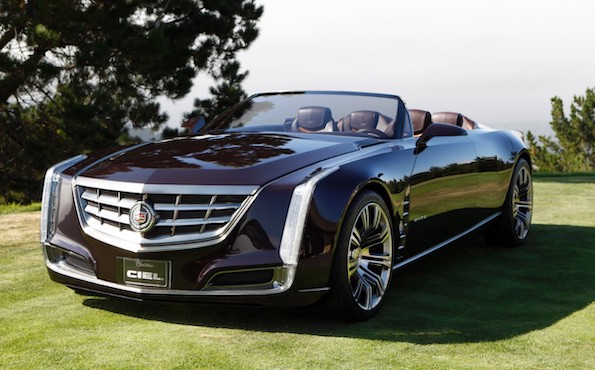
(GM)
The Cadillac Ciel.
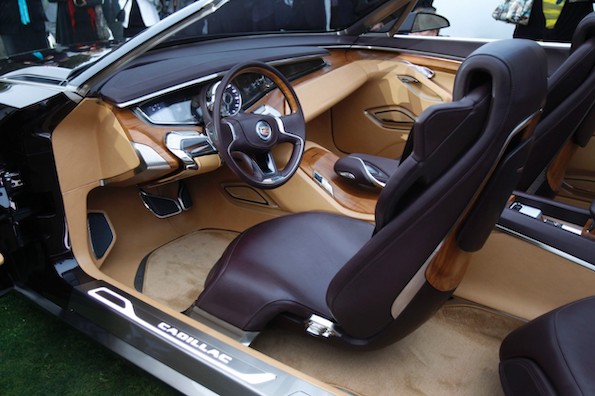
(GM)
The Cadillac Ciel.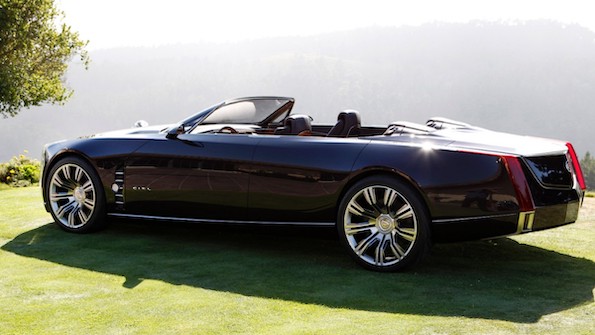
(GM)
The Cadillac Ciel.
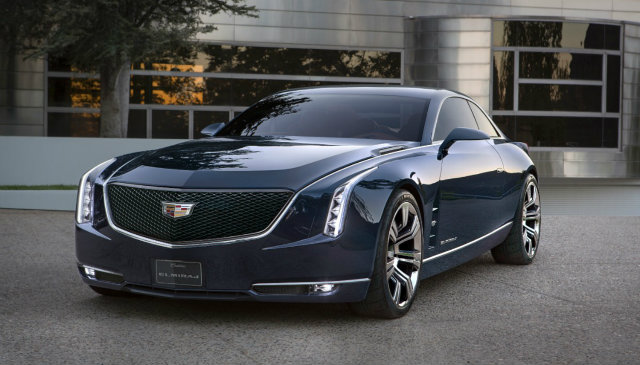
(GM)
The Cadillac Elmiraj.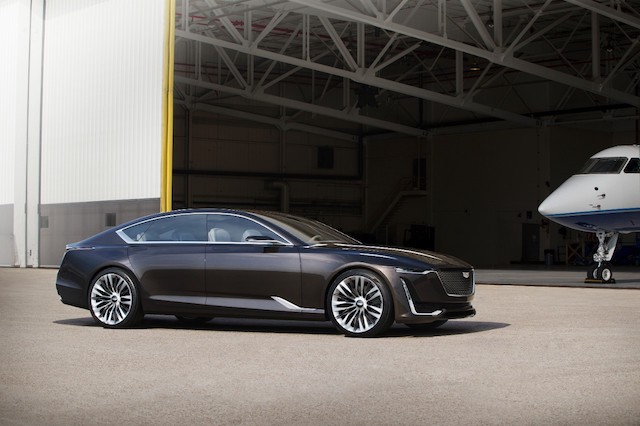
(GM)
The Cadillac Escala.
Delivering The Truth, The Whole Truth... and absolutely nothing but The High-Octane Truth has been an exhilarating ride. As for the whole ad agency vs. client thing, the profitability of the advertising business is being squeezed down to next to nothing, leaving agencies to fight over scraps while clients display the loyalty of your average fair-weather sports fan. In other words, the state of the ad biz when it comes to the auto industry is beyond pathetic. It’s no wonder that ad agencies have forgotten what their basic mission is – which is to deliver the best, most provocative communications on behalf of their clients that they can muster – in this toxic environment. Do clients still get the advertising they deserve because of it? Yes.
As for those aforementioned legions of Wimps and Twerps and “Yes Men” and “Yes Women” they’re all still present and accounted for – on both sides of the ball. I know, because some of the people who were shoveling shit in this town when I was still in the ad biz are still doing it today. And it’s unconscionable.
As for bad people making bad decisions negatively affecting good people who know better in this business, same as it ever was, unfortunately.
And what about that whole “joyful celebration of the indefatigable nature of the American Spirit and the role the automobile has had, continues to have, and always will play...” thing? Well, let’s just say that it’s a work in progress.
That “Detroit” finally got product religion and is saying and doing all of the right things is commendable, but there’s still the lingering fear that this business as practiced here will slip back into bad old habits at any given moment. Those shining beacons of product light and creativity are still threatened by churning storm clouds defined by a “three steps forward, five back” cadence of rampant mediocrity. And that is sobering.
Add in the great unknown of the autonomous vehicle movement, the hopeful nirvana of ride sharing and the promises of untold profits in a new Emerald Auto City just over the hill, and well, to say I am beyond skeptical would be an understatement. Let's just call it a giant "we'll see" for now and leave it at that.
Now, at the beginning of our 20th year, I am proud to say that we still take you "behind the curtain" to give you an up-close look at the Wizards, the Dullards and everyone else in between in this business. I still say what the others are only thinking (or whispering) in deep background or “off-the-record” conversations, and I will continue to do so. And this publication will continue to "influence the influencers" every single week, even though they're loathe to admit it.
Write Hard, Die Free indeed. (“WRITE HARD, DIE FREE CONTINUED.” – 5/30)
Automotive marketing is a very big deal. And expert brand image wrangling is a crucial part of making all of the effort to design and engineer great products worthwhile. Billions of dollars are spent on brand image wrangling by the auto companies each and every year. Why? Because having the “right” brand image is absolutely essential for market success. As you’ll see in my following commentary when a company does it well, it shows, but if a company misses even by a little, it can be very costly. And if a company’s marketers screw up, the effects can not only be devastating, they can linger for years.
Executives at the underperforming car companies get into trouble because they actually start to think that they’re selling something they’re not, which leads them to deluding themselves into thinking that their products are something other than what they are. In other words, an incurable case of brand delusion.
And when the people running the company don’t know how and why the brand earned its chops to begin with and are confused as to what their brand stands for now, how can they possibly guide it properly? The painfully short answer? They can’t. And even worse, they allow the wrong products to creep into their portfolios, which ultimately will lead to a corrosive level of brand dilution. The difference between getting things right and getting them horribly wrong when it comes to this brand image wrangling business is the finest of lines. But then again people are paid very well to do these jobs, so it’s okay to expect them to know what they’re doing, even though some clearly don’t. (“THE AUTOEXTREMIST BRAND IMAGE METER VII: THE ‘TRIFECTA OF NOT GOOD’ EDITION.” – 6/6)
Along with this municipal rejuvenation, the collective “Detroit” and its headlong rush into transforming itself from the Motor City into the Mobility City is the other Big Story. Ford and General Motors in particular are spending money on mobility – no matter what form it takes - like college kids on a drunken bender.
Why, you might ask? Because “Detroit” collectively doesn’t want to be left at the gate of the new mobility revolution, whatever that is. And it’s a noble notion to be sure. Detroit doesn’t want to cede its 120 years of transportation leadership to any other entity, especially to the Used-to-be-Masters of the Universe out in Silicon Valley, because it’s anathema to their very existence.
But therein lies the conundrum. Detroit is chasing the New Ghosts of Mobility, running after so many projects – both real and imagined – at such a dizzying rate that it’s beginning to feel forced, and more than a little dangerous.
Perhaps ominous might be the better word. Detroit is rushing to be a part of a movement that ultimately will destroy its raison d’etre. Every calculated move Detroit is making right now is based on the belief that the future lies in the planned obsolescence of its existence. And Detroit steadfastly believes that it can monetize this new mobility – from electric bicycles to autonomous balsa wood smiley cars – to the degree that untold profits will be automatic and considerable.
I’m not buying it. But the frequency of the “bunny rabbit and rainbow” pronouncements about the New Mobility emanating from Detroit PR operatives on a daily basis are begging us to think otherwise. Based on these communiqués you would think that the time-honored and classically Detroit doctrine of “it won’t be long now” was not only alive and well but thriving.
And that may be the most ominous development of all. (“CHASING NEW GHOSTS OF MOBILITY, DETROIT FACES AN UNCERTAIN FUTURE.” – 6/20)
Peak Fast. On Sunday, June 24, Volkswagen made history at the Pikes Peak International Hill Climb. Romain Dumas, driving the purpose-built, 500-kW (680 PS) I.D. R Pikes Peak, not only broke the previous record for electric vehicles, but also bettered Sébastien Loeb’s all-time course record from 2013 by a full sixteen seconds. Dumas attacked the 19.99-kilometer, 156-corner mountain course in a record time of 7m 57.148s minutes.
It was an incredible achievement, not just because the I.D. R Pikes Peak was developed and built in just 250 days in an all-hands-on-deck effort by the True Believers at Volkswagen, but because it represents the final, seismic, transformational shift to electrification in the automobile industry and for electric power in our mass-produced vehicles.
And what about racing? The sport is headed for a transition as well. It’s clear to me that even though internal combustion engines will be around indefinitely, racing is likely to become more of nostalgia exercise. That means major racing organizations will find it tougher and tougher to sustain what they do, so they will have to focus on fewer, bigger events (which, come to think of it, isn’t a bad idea at all). NASCAR in particular needs to get its arms around this idea, because unless major changes are made in that aging, oversaturated series it will go back to be a regional series like it was in the 60s and 70s.
No, racing isn’t going to disappear altogether and Formula E, the relatively new, all-electric racing series, will continue. (Although I was bullish on this series early on, my opinion of it has soured. Without the sound and fury of ICE-powered racing machines, the appeal of Formula E is severely limited.)
This transition of the automobile business will be pivotal and seminal. Traditional companies will survive with savvy and guile, while others will be forced to partner up in order to live to fight another day. And then again, some won’t survive at all.
Kudos to the True Believers at VW for establishing a new record at Pikes Peak. This was a no excuses, “run-what-you-brung” technical exercise and they nailed it by setting a new all-time record, bringing The Next Precipice right along with them. (“THE NEXT PRECIPICE.” – 6/27)
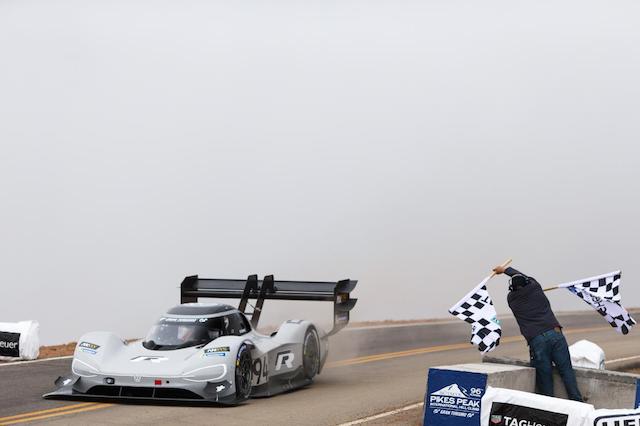 (VW images)
(VW images)
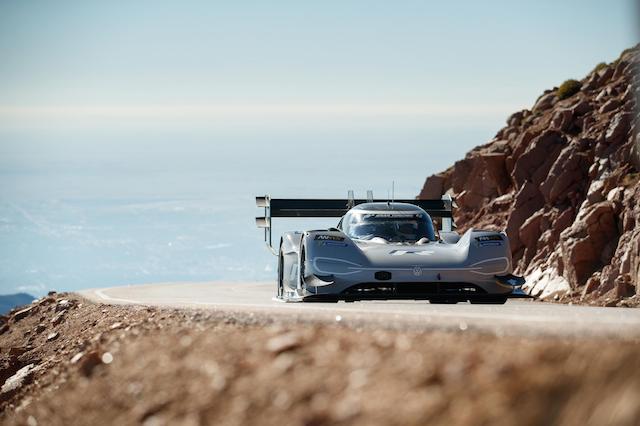
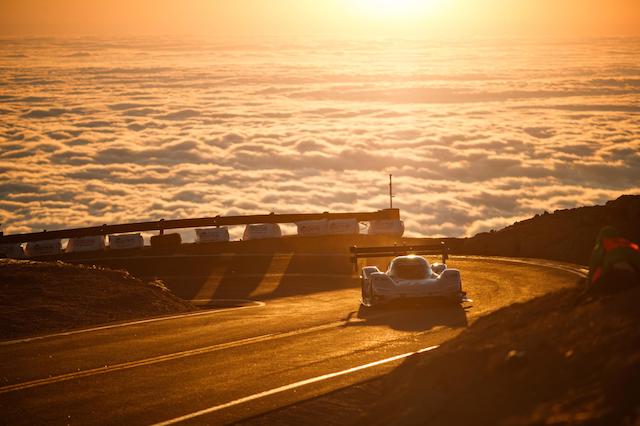
America Wide Open. Since this week’s issue falls on Independence Day, I thought it might be appropriate to take a time out and think about this country of ours and what it means to be free. If you’re so inclined, you should take the time and read the Declaration of Independence, because it is a most remarkable document with uncomfortable parallels to where we, as a country, find ourselves today.
It’s quite obvious that too many of us have lulled ourselves into taking for granted what it means to be really free, and it’s not hard to see why. Our most solemn national remembrances are now distilled down to days on the calendar for retail sales events, as if all of the sacrifices of the millions of men and women who came before us are mere backdrops for a deal on a couch.
That this is unsettling for a lot of people across the country is no secret, but it seems that any efforts to quell the commercialism surrounding Memorial Day, Independence Day and Veteran’s Day are dismissed as being inconsequential and unwanted.
No, I am not throwing ice water on what now passes for tradition in this country when it comes to Independence Day - the backyard barbecues, family get-togethers and fireworks, but it concerns me that a large faction of this country goes about making plans for “the 4th” completely and conveniently ignoring what it all means.
So, let this be the slightest of reminders, that you might pause at least momentarily to think about what Independence Day really means.
Let’s start with independence of thought. In a country that was founded on the fundamental principles of freedom, I can’t think of a more essential privilege of living here than the freedom to intellectually explore without the threat of reprisal. Yes, this one essential ingredient causes this country myriad problems at times, but it’s who we are and it’s what we do.
Then there’s independence of beliefs. Whether it be political or religious beliefs, we have rights in this nation that other people in the world can only dream about. People still want to come here based on these two factors alone, just as the original settlers of this land did.
An independence to roam. Now, I know this is a quality of living here that most people have all but forgotten, but we live in a vast country that’s as distinctive as the multiple geographies that define it. And we’ve been free to roam and wander and take it all in for so long that we find it hard to believe that places still exist in the world where you simply can’t do that. Dismiss this fundamental freedom of mobility at your peril, because it’s essential to the American experience.
Things may feel a little grim right now, but I don’t believe for a moment that we, together, can’t rise above the current rancor and savor the independence we all enjoy every single day. And it’s important to remember too that it is our unending privilege to honor those that came before us because we are reveling in the fruits of their sacrifices.
I could go on, but I will leave the rest of this to your own thoughts. Think about the big things and the little things that surprise you and at times astound you about living here. We are so very fortunate to be able to call America our home, because it’s a 24/7 experience that’s simply a wonder to behold. It’s America Wide Open, and I wouldn’t have it any other way. (“AMERICA WIDE OPEN.” – 7/4)
Motorama Detroit. With the Detroit Auto Show experience – and that’s what it must be – finally moving to one of this region’s most beautiful months – June - the previous limitations of biting cold, icy streets, treacherous sidewalks and bitter winds are immediately things of the past. This event should take on an immersive, almost Olympic-like quality, with events staged all over the city. Manufacturers should be encouraged to carve out space for experiential displays at venues they deem appropriate (especially with the Detroit Grand Prix weekend handily kicking off the proceedings), while keeping the core show at Cobo. People should be able to drive the cars and trucks, experience major league entertainment, sample the pulse of the city, and take in music and restaurants. I am talking a full week of events and attractions for all ages.
And one more thing, an event like this needs a new name. “Detroit Auto Show” won’t cut it, because this week-long event as redefined, deserves something more. Much more. Remember, the manufacturers will have a blank canvas, too, and they’ll want to showcase advancements in mobility and technology. This will have to be a very big deal if it has a chance at all.
Back in the 50s and early 60s, the “old” GM staged a traveling road show that showcased their products, from production cars to concepts. And it was exceedingly popular. The PR impact was huge, and it captured the imagination of the press and the consumer public. That show was called General Motors Motorama, and its impact still resonates to this day.
I don’t think GM CEO Mary Barra would mind at all lending the “Motorama” moniker to the auto industry extravaganza that will unfold here in the first weeks of June 2020. As a matter of fact, there’s a certain symmetry to the idea. Especially with the “new” Detroit trying to project itself as a glimmering beacon of hope in the darkness.
Showcasing a domestic auto industry emboldened with new products, new vision and a feisty new competitive spirit, augmented by a city that has been reborn and rejuvenated after years of being the country's punchline, one teeming with new enlightenment and perspective while pointing to a limitless future, is just what the doctor ordered.I think Motorama Detroit has a beautiful ring to it. (“MOTORAMA DETROIT.” – 7/11)
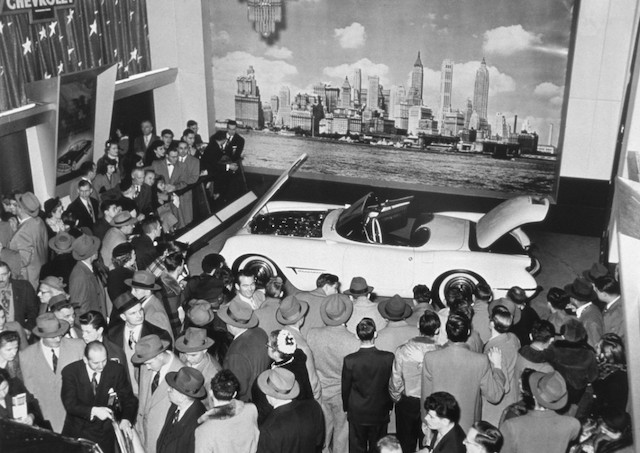
(GM images)
The 1953 Corvette was unveiled at the GM Motorama in New York.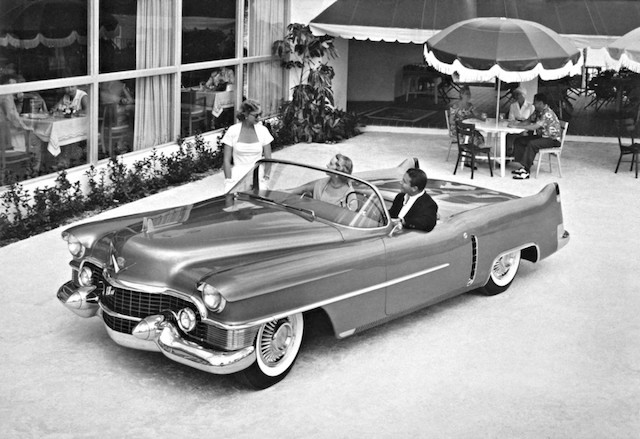 The 1953 Cadillac Le Mans concept was another GM Styling project unveiled at the GM Motorama.
The 1953 Cadillac Le Mans concept was another GM Styling project unveiled at the GM Motorama.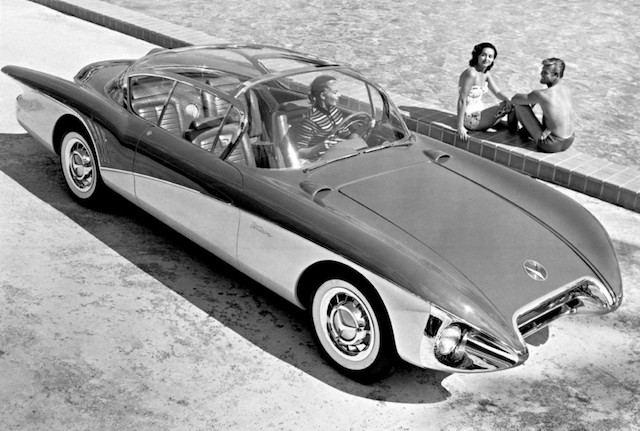 The 1956 Buick Centurion was a Motorama star.
The 1956 Buick Centurion was a Motorama star.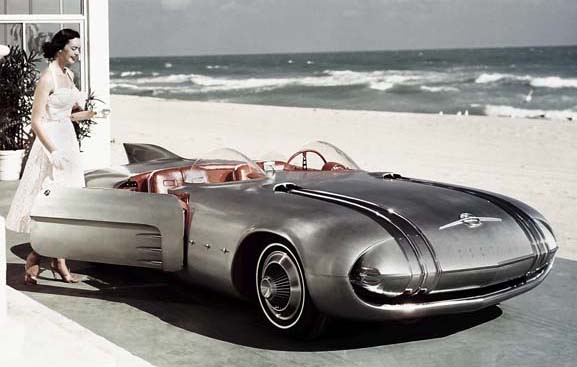 GM Styling cemented its visionary reputation with the 1956 Pontiac Club de Mer concept unveiled at GM's Motorama.
GM Styling cemented its visionary reputation with the 1956 Pontiac Club de Mer concept unveiled at GM's Motorama.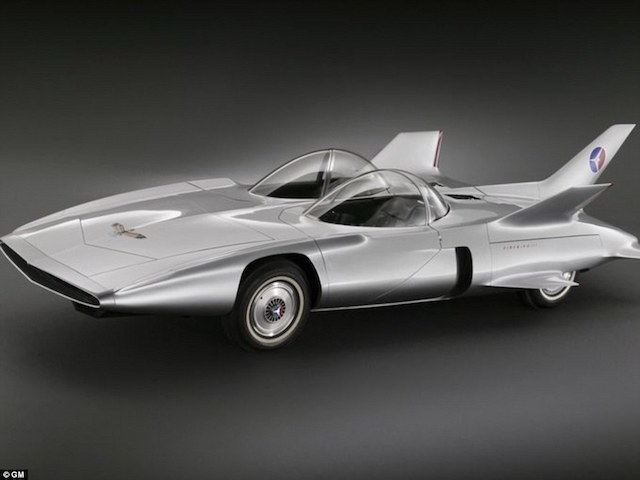 The radical, gas turbine-powered Firebird III was designed in 1958 and made its Motorama debut in 1959.
The radical, gas turbine-powered Firebird III was designed in 1958 and made its Motorama debut in 1959. 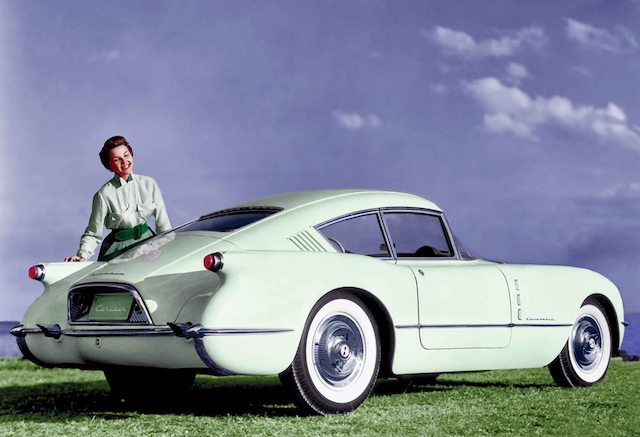 The 1954 Chevrolet Corvette "Corvair" was another concept unveiled at the Motorama.
The 1954 Chevrolet Corvette "Corvair" was another concept unveiled at the Motorama.
But today is about Sergio Marchionne. The likelihood that we will see another CEO like him is slim and none. Overlooking his Dark Side for a moment, he was the most colorful, shoot-from-the-lip leader this industry has seen in a long time. And even though I was his most consistent critic by far, I appreciated his passion, vision and enduring optimism. CEOs who tell it like it is, or how they think it is, are a lost and unique art. And there’s no question that Sergio Marchionne was artfully unique. (“AN UNFORTUNATE DENOUEMENT.” – 7/25)
Let’s just hope that these mobility futurists don’t get a hold of a copy of Soylent Green anytime soon. I predict that the transition to this Grand Transformation and the Future of Mobility is going to be a painful one. It’s not just the problems associated with the technology that are sure to come to light, it’s the fundamental phasing out of the idea of freedom that originally came with personal mobility that will become an issue.
This country was fueled by the freedom to roam, an enduring wanderlust that drove us to see, and to do, and to be. And we explored and settled its vastness with a relentlessness that knew no bounds. This individual freedom of mobility was part and parcel of the American spirit and it’s part of what made this country great. And now? We’re transitioning to a new dimension of mobility that will leave many out in the cold, and on many levels too.
The futurists are building on, remarkably enough, the pathetic concept of “over sharing” – the one that has paralyzed this country to the point that it has turned into a national nightmare fueled by the relentless din of social media – turning it into the defining platform for the future of our mobility.
The individual, as you might guess, will be marginalized, and for those who grew up with the concept of mobility being a form of individual expression, well, the sooner we shuffle off of this mortal coil, the better, because The Future of Mobility - as it’s being defined for us - will put a premium on nameless and faceless disengagement.
And the auto industry as we once knew it will be marginalized too. What once was considered to be the lower end of the market – the mundane, bottom-feeder “commodity” cars - will make up the vast majority of the transportation “devices” at our disposal. Yes, traditional brands will still exist at a premium – imagine an autonomous vehicle in a Mercedes or Porsche wrapper, for instance – so as to extract higher monthly fees, but that will be the extent of it. And remember, you might be willing to pay for that luxury wrapper, but you will still be “locked-in” to a system that will have zero tolerance for deviation.
What does this mean for the vibrant network of hot rod builders and gifted craftsmen and craftswomen who dot the landscape across the country, you might be wondering? I believe that they will in fact thrive in the gathering darkness of autonomy.
As long as there are people willing to seek out that last measure of individual expression and freedom of mobility on their own terms, there will be a shred of the American automobile culture, as we once knew it, left. And the gathering darkness of autonomy will be held at bay for a couple of decades, hopefully.
But let’s just hope that these mobility futurists don’t get a hold of a copy of Soylent Green anytime soon. That would be a giant bowl of Not Good. (“SHINY HAPPY RIDERS IN ZOMBIE CARS.” – 8/1)
NASCAR? It's a flat-out mess. It’s no secret that I have been NASCAR’s most outspoken national critic for more than a decade now, but I’ve always made the distinction between the corporate NASCAR, and the drivers, teams and technical people involved in the sport. These are some of the most talented people in all of racing and it’s a flat-out shame that they’ve been saddled with some of the most relentlessly mediocre corporate overlords working in the sport.
The list of negatives created by these corporate bumblers at NASCAR is lengthy. NASCAR has the worse death march of a schedule in all of sports (and with the NBA and NHL in existence that’s saying something), and its steadfast refusal to even entertain any changes to its calendar has been a tediously recurring joke. On top of too many races, the repetitiveness of the schedule and the double visits to the same tracks each season is almost incomprehensible. Everything about NASCAR is stale, and the stench of sameness hangs over the enterprise like a black cloud. The racing organization’s relentless intransigence and its strict adherence to “we’ve always done it this way,” combined with the most virulent strain of “not invented here” that you’ll ever see, have created a moribund corporate entity in need of a giant kick in the ass.
With Brian France’s latest and hopefully final episode, the auto manufacturers have some decisions to make. They must finally take the gloves off and get directly involved in the future of NASCAR, because the way these manufacturers have been operating up until now - this "go-along-to-get-along" drill - is simply unacceptable. If the racing entity is to be sold, then the manufactures have to be included in all discussions because without their participation, whatever form NASCAR takes going forward simply wouldn’t be able to get off of the ground. There’s hope that in Jim France, NASCAR’s interim chief - who is everything Brian France isn’t in that he’s politically and racing savvy, sharply aware and decisive in action - NASCAR has a chance to right itself and move forward. But it’s a giant “we’ll see” at this point.
Changes for NASCAR have been long overdue. It’s ironic that Brian France’s giant flameout and permanent exit might just allow him to finally accomplish something good for the family business. (“THE NASCAR MESS.” – 8/8)
A full-blown Muskian nightmare. Yet Elon Musk was allowed to continue one of the biggest scams perpetrated in American corporate history with no profits, myriad production snafus, endless quality and people problems, a new model that was a complete and utter disaster, and on, and on, and on.
But the other dimension of this story that came to light is the exposed fragility of Musk himself. In a now-infamous interview in the New York Times ten days ago, Musk, when asked about his current state, had this to say: “This past year has been the most difficult and painful year of my career,” he said. “It was excruciating.”
This interview occurred not long after Musk had hastily erected a massive tent outside of the Tesla manufacturing facility to accelerate the build of Model 3s. (He’s even sleeping in the factory to focus on getting the Model 3 models built.) And then there was his infamous Twitter missive insisting he had a buyer for the company, funding secured. It was a mark of blatant desperation, a diversionary tactic that exposed Musk for who he truly is: someone who is quick to throw out ideas – rational or not – but who, when the chips are down is incapable of following up on them.
In the end, making brilliant pronouncements was easy for Musk, but delivering a quality, mainstream automobile was another thing altogether, and it would prove to be his undoing. In other words, a full-blown Muskian Nightmare.
Musk, it turns out, for all his bluster and swinging dick-ism, is no different from any other egomaniacal corporate leader who has come before him. I know this pains his blind loyalists who refuse to accept the fact that St. Elon is merely mortal, but so be it.
Yes, Musk is brilliant and visionary, but he’s burdened by the same thing that has vexed countless leaders who have come before him: an incredible level of unfettered hubris that is relentlessly untethered to accountability. No one tells Musk “no” and gets away with it, because after all, when he’s all-knowing and all-seeing, why ask why?
I predict that Musk will sell his automobile operations because he has painted himself into a corner, and there’s no elegant way to get out of the hole he’s put himself – and his company – in. Yes, he did some notable things in his automotive venture, but it wasn’t enough to sustain an actual profitable business model. Oh yes, and he will probably go out while castigating the “moribund” domestic automobile industry, insisting that he showed the world how it’s done. But in the end, for all his brilliance, Elon simply couldn’t get it done. (“A FULL-BLOWN MUSKIAN NIGHTMARE.” – 8/29)
Maybe those thick black clouds off to the horizon aren’t clouds after all. To say this nation isn’t ready for this transformation to electrification is an understatement. The infrastructure just isn’t there, no matter how optimistic the projections are for charging stations coming online. For instance, have you been to a large metropolitan airport lately? Have you seen the limited number of chargers available? Can you envision a whole floor of your airport's parking structure given over to charging stations? Yeah, I didn’t think so. But then again this is just one dimension of this “mass electrification” impetus that has to be dealt with.
The other? Widespread consumer acceptance of fully-electric vehicles is another issue altogether. I’m not talking about the early adopters here, because those people don’t have to be convinced; they’ve already bought in all the way. But what about the rest of the automotive shoppers out there in ConsumerVille? What about the people who make real monthly payments on vehicles they need and/or want? Do you think the notion of fully-electric vehicles will be a slam dunk to these consumers? Think again, because if that were the case the Chevrolet Bolt would be flying off the lots as Chevrolet’s top seller just this side of the Silverado pickup. And though the Bolt is an impressive, well-engineered vehicle and is doing fairly well of late, it’s not even close to that kind of retail acceptance. (And the same goes for the VW e-Golf too.)
And I haven’t even gotten to the cost of these BEV machines. The announced prices for Audi’s new E-Tron SUV are, ahem, impressive. The E-Tron is available in three trim levels: Premium Plus ($74,800), Prestige ($81,800) and First Edition ($86,700). And remember, this is for an Audi Q5-sized SUV. And with government incentives receding into the woodwork, do you really think consumers are going to rush in to go fully-electric? Let’s just say that I am highly skeptical. The marketing and advertising of fully-electric vehicles is going to be nothing short of the biggest single challenge facing automotive marketers in the coming years.
So here we are. Before this business can get its autonomy on, it’s going to have to get its electrification on. But before it can get its electrification on, this business has to deal with the fact that the vast majority of the cars and trucks being sold over the next ten years will be traditional, ICE-powered vehicles.
Maybe those black clouds off to the horizon aren’t clouds after all. Instead, maybe it’s the smoke from a distant fire that’s threatening to consume everything in this industry’s path. (“THE SMOKE FROM A DISTANT FIRE.” – 9/19)
Runnin’ Down A Dream. Deep in the throes of another sleepless night, delirious with the knowledge that it was the early hours of Wednesday morning and I still hadn’t written a column, the urgent, searing guitar riffs of one of Mr. Petty’s signature songs took over my thoughts.
And suddenly, it was 2030.
I stepped out into the darkness, wandering around in a world that looked, well, remarkably as it looks today. I noticed a few stray autonomous vehicles doing their rote routines, with their blue LEDs indicating what they were. But they were - not surprisingly - insignificant, part of the thrum of a new reality, but only a bit part.
And as the darkness lightened slightly, I started to see the ebb and flow of traffic on Woodward Avenue. Some avant-garde designs were noticeable - aero shapes punctuated by their wildly diverse lighting systems - but they were clearly full-zoot luxury machines. Other cars were decidedly less adventurous, a mix of small to medium sized conveyances that really didn’t look all that much different from today. And yes, the traffic flow was dominated by SUV-like vehicles still, the American consumer having long ago abandoned any thought of going back to a typical passenger car.
The sounds were diverse too. A mix of BEV whine, hybrids and yes, full-on ICE machines as well. It was obvious that the prognostications of a complete transition to BEVs were dead wrong. The “grand transformation” was clearly a work in progress, with scores of people happily clinging to their piston-powered vehicles for two reasons: cost and the freedom of movement with no limitations. I did notice that as I walked past the local Speedway gas station/convenience store, a row of quick charging stations for BEVs had been added. They were empty now, but the gas pumps were already busy.
I found myself back at my computer and I began to peruse some of the stories. The “C” of FCA had been bought out eight years ago, so Jeep and Ram Truck were now part of the Hyundai Group, with the Italians keeping control of Alfa Romeo, Ferrari, Fiat and Maserati.
The Toyota conglomerate now included Honda and Mazda - as completely separate entities - as well as Subaru. And Lexus survived as a fully-electric brand after Toyota bought out the assets of Tesla, which had gone bankrupt eleven years earlier. Peugeot-Citroën had taken over Renault and solidified into one company, with Nissan being absorbed and rebranded as Datsun worldwide, Infiniti having been discontinued.
Daimler and BMW had entered into a joint operating agreement; both Mercedes and BMW retained product independence in the new German company and were joined by Aston Martin, which finally ran out of time and money trying to keep its luxury brand afloat.
The VW Group long ago established itself as the largest automotive conglomerate in the world. The news? Its working agreement with the Ford Motor Company had evolved into a full takeover, as Ford’s restructuring was stalled by its perpetually late product cadence, ineffectual leadership and having pissed away billions trying to become a mobility company. And for the first time in its history Ford was no longer controlled by the Ford family, although the family still maintained a significant - but notably reduced - presence in terms of stock and influence.
And what of GM? Dan Ammann had succeeded Mary Barra, with 99 percent of the company’s profitability originating in China. The Buick, Cadillac, Chevrolet and GMC divisions remained, with Hummer having been resurrected from the scrap heap and brought back to prominence. Those brands were now joined by Jaguar and Land Rover, as GM became part of the Tata conglomerate in 2025.
The most amazing thing I discovered in my future dream was that all of the hundreds of billions of dollars spent on the development of autonomous vehicles had turned out to be the biggest financial disaster - this side of The Great Recession - in automotive history. The focus on autonomous conveyances and the promise of a Utopian future of no-involvement ride sharing and rent-by-the-minute usage had devolved into lawyered-up tech companies fighting over a few big municipal fleets, contracts with the U. S. Post Office and very narrowly-focused utilization for the elderly. The Masters from The Valley of Silicon were incredulous that consumers just didn’t buy into their all-encompassing brilliance.
The wholesale consumer acceptance of mass usage rental vehicles turned out to be a mirage, as real people with real lives convincingly reminded the brainiacs that the reality of mass ride sharing just doesn’t work in the real world, where the comings and goings of an average family will never fit into a perfect little autonomous box.
The brightening sky was now getting dark again, as storm clouds rolled in from the west. I went out and fired up The Beast one more time, just to remind myself that the memorable moments in life are fleeting and precious, and still worth pursuing.
And then I woke up and began writing...
I’ll leave it to Mr. Petty to close this one out:
I rolled on as the sky grew dark
I put the pedal down to make some time
There’s something good waitin’ down this road
I’m pickin’ up whatever’s mine
I'm runnin' down a dream
That never would've come to me
Workin' on a mystery, goin' wherever it leads
Runnin' down a dream
(“RUNNIN’ DOWN A DREAM.” – 9/26)
What does it all mean? As I said, our individual and collective experiences with cars and being on the road are seared in our memories and are irreplaceable. Where we’ve been has everything to do with who we are. This nation was transformed with a wandering spirit that allowed us to roam for the sheer hell of it. And our culture was and is still defined by it.
I’m afraid if we lose that piece of who we are, we will lose a large part of the soul of this nation. Our machines may change but our need to wander never will. That’s why this headlong rush to AV and AI leaves me cold. It may have its place in extremely limited applications in select urban centers, but any expectation that it will grow to be more than that is a dead end. As for the title of this week’s column, it’s an homage to the memorable Eric Clapton/George Harrison composition “Badge,” as performed by Cream. (“THINKIN’ ‘BOUT THE TIMES I DROVE IN MY CAR, PART I.” – 10/17)
Am I shocked by all of this? Not at all. Automotive marketing as practiced around here rarely leads. It is a reactive, hackneyed, mishmash of recycled ideas marked by obvious and predictably mundane choices. Yes, there are flashes of creativity and even moments of fleeting brilliance, but it is never sustained, and it never becomes standard operating procedure. Why? The “system” just won’t allow it because these companies are only capable of understanding the power of excellent marketing after the fact, or when someone else does it first, which is the quintessential bowl of Not Good. (“PERPETUALLY LATE TO THE PARTY.” – 10/31)
Memo to auto executives: Leave the eBikes and the meBikes to the others – and get back to work. The Valley of Silicon’s effect on the automobile companies and their executives has been a sight to behold, and in the most negative way possible too. Tired of being pummeled by the most virulent strain of Washington bureaucrats in this nation’s history, and tired of being perceived as perpetually unhip, uncool and even worse – obsolete and outdated – especially in comparison to the West Coast Digital Intelligentsia, the Detroit executive mindset (and I am including all auto companies in this description) has gone completely off of the rails.
And they’re striking back with a fury, except that in many instances that fury is misguided and marked by highly questionable decisions that will come back to bite them in the ass, hard. Yes, I am acutely aware that in our Digitized Future IT will rule and IT minions will inherit the earth, but this is getting ridiculous. The collective Detroit “mindset” has completely forgotten what its role should be and will be when it comes to the future of mobility.
Let’s not forget that the one thing that the Masters of The Universe out in the Valley of Silicon have come to respect and marvel at about “Detroit” is just how relentlessly complicated designing, engineering and manufacturing vehicles that not only work and perform with remarkable reliability but do so while complying with international safety and emissions standards really is. It is one of the most challenging business pursuits on earth, and to do it while delivering a modicum of profitability makes it all that more difficult.
I appreciate the challenges facing the auto company executives, and just how much they are determined to be part of the Future of Mobility, but to entirely lose their collective minds in the process is inexcusable.
They need to be reminded that what they do is a unique pursuit, and to create machines that are reliable, efficient, and perform well to their stated missions while being compelling to look at is a calling still worth pursuing, one that isn’t going to become obsolete anytime soon. (“THE DETROIT EXECUTIVE MINDSET GETS DERAILED. AGAIN.” – 11/14)
But Ghosn has always been a particularly hard case, hoodwinking his fellow Japanese and French executives into believing that perhaps he did really walk on water, and that to have the temerity to question him usually led to an executive’s swift demise.
I saw through his act almost from Day One, and I winced every time I read another glowing review about the “brilliant” Ghosn. And it was all there too. The incomprehensible schedule. The almost incomprehensible depth and breadth of knowledge. The ability to keep multiple balls in the air that would flummox mere mortal executives. The carefully crafted aura of The Legend.
And it was all unmitigated bullshit, as the news of the day proves. Ghosn’s arrogance was boundless, and his hubris was uncontrollable. He was just the latest in a long line of Unctuous Pricks in this business who was allowed to run roughshod over everyone around him and not only lived to boast about it but thrived on every last morsel of the legend that was created around him. So, of course he skimmed millions, and of course he thought he could get away with it. Because when all was said and done, he was above it all.
He. Was. Untouchable.
Now, Carlos Ghosn is yet another cautionary tale in a long line of cautionary tales that this business has been subjected to over the decades. It’s a story that has played out time and time again: The arrogance. The hubris. The manufactured aura. And then, the inevitable denouement. He won’t be missed. (“THE UNTOUCHABLE GOES DOWN.” - 11/21)
#IUSEDTOWORKFORGM. And while you’re contemplating that thought, here’s GM basically talking out of both sides of its mouth, laying off and firing “old tech” workers while hiring “new tech” workers for its vision of The Future filled with shiny happy BEVs, and even shinier and happier Autonomous vehicles. A future that is purely speculative at this point, by the way, but you can bet GM will be doing everything in its power to convince people to buy and drive their BEVs simply by not building vehicles with ICEs anymore.
Sounds like a plan, right? Not really. Because in GM’s case it’s very shaky one, at best. After all, this is a company that builds the Chevrolet Bolt, an excellent BEV, by the way - except for being yet another example of GM’s notoriously lackluster interior design capability – and they can’t sell it enough to make any noise in the market at all. Yes, GM marketing, those consummate experts at doing less with more than any other automotive marketer on the planet are the culprits here, yet again, but GM is going to flip a switch and have consumers beating their dealers’ doors down to get their hands on a brace of new BEVs? I don’t think so.
GM’s PR minions are already spinning this as the company taking the necessary but challenging steps on the way to a productive future with wildly impressive profit potential, promising to improve annual cash flow to the tune of $6 billion by the end of 2020, but who’s kidding whom here?
Now, it should be said that the “new” GM, burned by years of serial mediocrity because of reacting to market conditions and changes instead of getting out front of them should be commended for these actions, and CEO Mary Barra is reaping the benefit from analyst accolades, who are already calling the restructuring hugely beneficial and smart. And true to form, the denizens of Wall Street have already weighed in, too, spiking GM’s stock price.
But CEO Mary Barra is walking on sunshine here – and blowing a lot of smoke too – promising the moon and the stars as long as we don’t look too closely or pay attention to those things that she doesn’t want us to pay attention to. GM’s track record in marketing is so reprehensibly bad that if those so-called analysts bothered to dig deeper, they’d realize that Barra’s plan is beyond frightening, and the company’s stock price would be plummeting instead of enjoying a spike.
The bottom line is that GM can’t get where it says it wants to go. It is planning for an electrified future that only exists in projections, and on top of that, the company has demonstrated conclusively that it can’t market its way out of a paper bag. Oh well, at least it has the capability to keep cranking out ICE-powered crossovers and SUVs, at least until they start jamming BEVs down consumers’ throats.
GM has a social-media hashtag rolling around – #IWorkForGM – that supposedly stands for the pride and passion that come with being associated with – and employed by – the company. Unfortunately for the people on their way out at GM, my hashtag headline is more accurate. (“#IUSEDTOWORKFORGM.” – 11/28)
But as much as the road to The Future is paved with good intentions, there’s a high probability that unforeseen obstacles are going to disrupt the self-proclaimed disruptors. And it won’t be pretty. Legacy auto companies downloading huge sums of cash into the AV space are gambling the future of their companies on an idea bolstered by a wing and a prayer. It’s a Faustian bargain with no guarantees. There’s a stark either/or quality surrounding all of this. If they guess right, they will live to fight another day and maybe even tap into a revenue stream of gargantuan proportions. If they guess wrong, it could mean the permanent end of their involvement in the automobile business.
I’m getting the distinct feeling that for two of the companies involved in the AV pursuit – Ford and GM - there is no “Plan B.” They’re neck-deep all-in, to the detriment of their ongoing business. Sure, they will vehemently deny this is so, that they have things under control and that they understand the need to balance their traditional business with their future endeavors, but who’s kidding whom here? As I’ve said before, I understand the Detroit executive mindset to a “T.” I know the way they think and why they’re thinking it, and I understand how they approach their assignments. AVs are the latest shiny objects, and these companies are willing to jettison seasoned executives by the thousands in favor of younger digital disciples who will competitively project these companies successfully into the AV circus. It’s amazing how much Detroit executives look like short-term thinkers while they’re delving into The Future. It’s the damnedest thing, in fact.
Yes, to some I will be immediately dismissed as a dullard and thrown in with The Unenlightened who will be stubborn obstacles on our Path to The Future, and so be it. I’ve been in and around this business for a long time, however, and I have observed as executives have made the same mistakes over and over and over again. They just can’t help it.
I will admit that, as shiny objects go, the promise of AVs is a wondrous thing filled with superlatives and bathed in the glow of a future society that’s somehow inherently better, so what could possibly go wrong? (“WHAT COULD POSSIBLY GO WRONG?” – 12/12)
In closing, I’m not in the platitudes business, in case you didn’t notice. Saying it has been another tumultuous year isn’t the half of it. As Cameron Crowe so eloquently wrote in “Jerry McGuire,” it can be an “up at dawn pride swallowing siege” for those of us immersed in this business. This business is a kaleidoscope of every human dimension, some good, some bad, and some just plain ugly.
But roaring through life hard on the gas can be an exhilarating ride. It’s visceral, it’s dynamic, it’s loud and colorful at times, and it can be full of memorable stories and experiences that stay with you forever. There are certain pursuits that allow us to experience life out loud like this, and more than a few of us actually get to do what we want to do. For many, however, societal demands force us into a go-along-to-get-along dance of drudgery that gets old almost from the moment you sign up for it. Sure, there are fleeting moments of pure joy, but it’s always punctuated by the sheer sameness that’s part and parcel of the day-to-day reality of it all.
Needless to say, writing for this publication is no dance of drudgery for me. Yes, it’s demanding, relentless and never-ending, but I wouldn’t have it any other way. Phoning it in is never an option here. I show up and bring it every week because that is what is expected of me, by me.
That this publication fundamentally altered the way this business is covered and written about can’t be denied. And that is tremendously gratifying. Being part of the go-along-to-get-along posse was never going to work for me, and that this has rankled many in this business is no secret. (I have been on more “enemy of the state” lists at the various car companies than I can even count.) The resentment toward me stems from the fact that I don’t play the game the way it has been played – the way it should be played, according to some – for decades before I arrived on the scene.
Up until I came along, access to auto executives was the name of the game for auto journalists. Access was the carrot that PR chiefs dangled – if you played nice and sprayed around the appropriate stories that were favorable to the given auto company – then you were considered one of the “good” ones, and you were granted access to one-on-one interviews and “exclusives.” The PR chiefs were happy, the journalists were happy, and more important, their editors were thrilled that their charges were getting insider scoops ahead of the competition.
Then I came along and messed with the status quo. I grew up being exposed to some of the legendary titans of this business, and I learned early on what made auto executives tick. I didn’t need access to the modern-day auto executive mindset because I knew how their minds worked. I knew how they approached things, I knew what they were thinking even before their closest colleagues did, I knew to whom they were beholden and why, and I knew where they lived, what they liked and where they were coming from.
So, when I started Autoextremist.com with the column entitled “White Boy Culture” nineteen-and-one-half years ago, to say it was a shock to the order of things in this town was the understatement of understatements. From that moment on I named names, and I exposed the insider stories that were only whispered in “off-the-record” conversations and in late-night bar talk by journalists. I took particular aim at GM not long after with “The Sad Saga of Saturn," and from that moment on my “relationship” with GM was toxic because I knew too much, and I made a point of saying it down to the last, excruciating detail.
Needless to say, this didn’t sit well with a lot of people. Why couldn’t I be “nice” and do “nice” stories like the others? Why couldn’t I just go with the flow? Things would be so much better if I played along and didn’t write “those” kinds of columns. Yes, it would be, but for whom? The PR chiefs? The executives who wear their egos on their sleeves, some who are so thin-skinned and insecure that it’s painful to observe? How about the business as a whole? Wouldn’t it be nice if I was a cheerleader for the good of the team?
How about no? Dispensing platitudes and “attaboys” has never been for me. I don’t think you should get a trophy for just showing up and participating. It stinks in Little League and it really stinks when we’re talking about how the global automakers conduct their business.
These companies don’t want to be exposed when they’re screwing things up or phoning it in. They don’t want to be reminded that they’re woefully late to a segment or that their product cadence is unfolding at a glacial pace. These executives don’t want to be called out for bumbling their way through their jobs and leaving a trail of mediocrity in their wake. And the so-called marketing “stars” at these companies don’t want to be reminded that they can’t seem to market their way out of a paper bag and that their serial careening is doing deep damage to their company brands.
As we like to remind people around here, the High-Octane Truth hurts. It doesn’t suffer fools, and it has no time for pretenders or dilettantes. It acknowledges the True Believers who give it their all every day to make things better but offers no quarter to those who are content with mediocrity, or even worse, those who run amuck with impunity.
This hasn’t been an easy road for me, but living out loud never is. So few of us get to do what we want to do that I will never allow myself to take this for granted, and the memorable stories and experiences will stay with me forever. I call them as I see ‘em and I will continue to do so. When people agree with me, I’m a hero, and when they don’t, I’m an asshole. Thus, it was ever so.
And I wouldn’t have it any other way.
Thank you for reading and thank you for listening. WordGirl and I wish the best to you and yours for a peaceful New Year.
We’ll see you back here on January 9th.
And that’s the High-Octane Truth for 2018.




